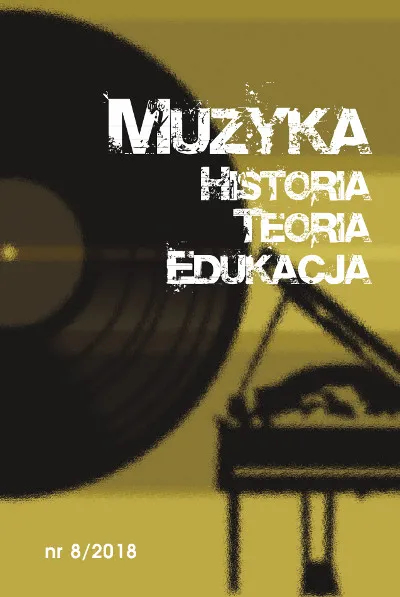Between music and literature Franz Liszt’s piano paraphrase of a romantic song - towards an interdisciplinary analysis
DOI:
https://doi.org/10.34767/MHTE.2018.01.06Abstract
The present article is concerned with the connection of literature with music (music with literature), that is the relationship between two distinct media. It aims at investigating the said relationship on the basis of Franz Liszt’s piano treatments of Schubert’s songs.
two pieces were selected for an in-depth analysis: The King of Alders (one of Schubert’s early works) and The Linden Tree, which represents the mature period of the author of more than six hundred songs. Exploring the connection between lyric poetry and music first in a song and then in a paraphrase is not an easy task, for it requires a particular approach to examination, in which none of the arts must be wronged. therefore, this work is an attempt to perform an interdisciplinary analysis and interpretation which engages three forms of artistic expression: poetry, Schubert’s song and, finally, the treatment of this song. This work constitutes an attempt to perform an interdisciplinary analysis. A rather broad analysis, for we start with the text and uncover all of its possible contexts; we also turn our attention to the architectural side. Without poetry – let us be honest – neither the song nor the following paraphrase would exist. Then we turn to the song, examining the intertextual strategies employed by the composer, and which of the text’s characteristics he expressed in his music and which he did not. At the end, we focus on Liszt’s paraphrase itself. We consider the intermedial efforts the composer makes (taking into account the accompaniment and vocalisation), and the contents he introduces regardless of the song which is the point of departure. Liszt’s treatments, according to us, refer not only to the paraphrased piece, but predominantly constitute an interpretation of the poem itself. Therefore, it is fair to say that Liszt returns to poetry, searching it for new senses. The present work constitutes an attempt to demonstrate this return.
References
Balbus Stanisław, Interdyscyplinarność – intersemiotyczność – komparatystyka, [w:] Stanisław Balbus, Andrzej Hejmej, Jakub Niedźwiedź (red.), Intersemiotyczność. Literatura wobec innych sztuk (i odwrotnie), Wydawnictwo Universitas, Kraków 2004.
Bristiger Michał, Związki muzyki ze słowem, PWM, Warszawa 1986.
Golianek Ryszard Daniel, Narodziny muzyki z ducha literatury. Typy znaczeń w poematach symfonicznych Franza Liszta, [w:] Stanisław Balbus, Andrzej Hejmej, Jakub Niedźwiedź (red.), Intersemiotyczność. Literatura wobec innych sztuk (i odwrotnie), Wydawnictwo Universitas, Kraków 2004.
Grzędzielska Maria, Elegia, [w:] Józef Bachórz, Alina Kowalczykowa (red.), Słownik literatury polskiej XIX wieku, zakład Narodowy im. Ossolińskich, Wrocław 2002, s. 223-225.
Hejmej Andrzej, Muzyka w literaturze (Perspektywy współczesnych badań), „teksty Drugie” 2000, nr 4.
Hejmej Andrzej, Muzyka w literaturze, Wydawnictwo Universitas, Kraków 2008.
Helman Alicja, Problem syntezy sztuk w świetle semiotycznej koncepcji systemów złożonych, [w:] Teresa Cieślikowska i Janusz Sławiński (red.), Pogranicza i korespondencje sztuk. „z dziejów Form Artystycznych w Literaturze Polskiej”, Wydawnictwo PAN, Wrocław 1980, s. 7-20.
Hryszczyńska Helena, „Erlkoenig” Goethego w pieśniach Reichardta, Schuberta i Moniuszki, „Muzyka i Liryka” 1991, t. 3, s. 59-69.
Kleiner Juliusz, Ballada, [w:] Józef Bachórz, Alina Kowalczykowa (red.), Słownik literatury polskiej XIX wieku, zakład Narodowy im. Ossolińskich, Wrocław 2002, s. 72-75.
Kopaliński Władysław, Drzewo, [w:] Władysław Kopaliński, Słownik symboli, Wiedza Powszechna, Warszawa 1990.
Kostrzewska Hanna, Analogia i muzyka. Z filozoficznych zagadnień muzyki, Akademia Muzyczna im. I. Paderewskiego w Poznaniu, Poznań 2001.
Polony Leszek, Liszt, [w:] Elżbieta Dziębowska (red.), Encyklopedia muzyczna. Część biograficzna, t. V („KLŁ”), PWM, Kraków 1997.
Poniatowska Irena, Muzyka fortepianowa i pianistyka w wieku XIX, Oficyna Wydawnicza „Rewasz”, Warszawa 1991.
Riffaterre Michael, Semiotyka intertekstualna: interpretant, „Pamiętnik Literacki” 1988, z. 1.
Seweryn Agata, Poezja „nutami niesiona”. O muzycznej recepcji twórczości Juliusza Słowackiego, Wydawnictwo IBL, Warszawa 2008.
Sławiński Janusz, Elegia, [w:] Michał Glowiński, Teresa Kostkiewiczowa, Aleksandra Okopień-Sławińska, Janusz Sławiński, Słownik terminów literackich, Wydawnictwo Ossolineum, Wrocław 1989.
Trzęsior Marcin, Pieśni drzemią w każdej rzeczy. Muzyka i estetyka wczesnego romantyzmu niemieckiego, Wyd. Uniwersytetu Wrocławskiego, Wrocław 2009.
Wasilewska-Chmura Magdalena, Przestrzeń intermedialna literatury i muzyki, Wydawnictwo UJ, Kraków 2011.
Witkowska Alina, Mickiewicz. Słowo i czyn, PWN, Warszawa 1986.

